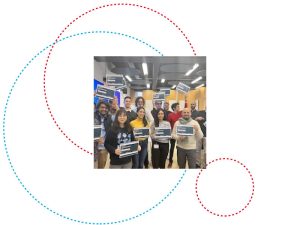At 8:30 am on 4 April, 14 students made their way to the Concurrent Design Facility (CDF-LU) on the Kirchberg Campus to participate in an intensive five-day challenge organised by the European Space Agency (ESA). In the 2022 edition of the ESA Concurrent Engineering Challenge (CEC 2022), the mission of the CDF-LU team was to design a satellite architecture to orbit the moon and determine the exact location and amount of water that exists there.
Concurrent engineering is an approach to designing space systems where all the different parts of a large system are created simultaneously, instead of one after the other. The benefits of this approach include cost effectiveness, as well as shorter project durations. This design approach is applied by space agencies such as ESA and NASA, as well as many other industry leaders, to design space systems- from launch vehicles to satellite payloads. A concurrent design facility (CDF) is a purpose-built lab for implementing this collaborative design and engineering, and SnT unveiled ours (known as the CDF-LU) in 2020 following the launch of the University of Luxembourg’s Interdisciplinary Space Masters (ISM).
Dr. Loveneesh Rana teaches the ISM modules on space mission and spacecraft design every week from this lab, but that Monday he and his lab became the five-day home for 14 ambitious students looking to gain a unique experience in space systems design. Half of the group was made up of students from the ISM programme, while the other half were SnT PhD candidates.
Two other CDF teams also participated in the ESA Concurrent Engineering Challenge that week, one from EPFL in Lausanne and another team made up of students from all over Europe hosted by ESA ESEC in their Belgian training facility. The challenge itself, to design a reflectometry mission to find exact information about the location and amount of water on the moon, was proposed by the CDF-LU.
There may have been three teams, but there was no winner. Having the experience itself was the end goal. “In the real world a project like this, to design a space system completely, would take at least a month,” said Dr. Rana. “The whole idea of this ESA challenge was to give the students the opportunity to participate in a concurrent engineering activity where they experienced the early design phase, so the ‘challenge’ was to get it done in five days!”
Concurrent engineering at its very heart requires a large team of people to be focused on the same project at the same time, so this ESA challenge was a truly unique opportunity for the students. While each team worked on their own design there was also collaboration across the three teams. “We organised wrap-up calls at the end of each day, but there was a lot of back and forth between the three teams, and sometimes one team would inspire another,” said Dr. Rana. The CDF-LU lab in the Kirchberg campus has microphones at each workstation, and there is a reason for them. The concurrent engineering approach requires constant contact and collaboration between each system specialist. “On the last day I realized I should have had a whistle! It is very fast-paced environment, and because we were working on a five-day timeline everyone had high energy.”
The final mission solution proposed by the SnT team was to send one ‘mothership’ satellite to orbit the moon and deploy small CubeSats to conduct reflectometry close to the surface. “We know that there is water on the moon, but we don’t have specifics and those are needed in order to one day realize a lunar infrastructure,” said Dr. Rana. “The mission required the students to monitor water at two different depths of lunar regolith, and so they had to create an architecture that could get close to the surface.”
All teams completed their design on time, bringing the challenge to a successful end. “We had a small celebration ceremony that Friday evening after the final results presentation,” said Dr. Rana. “We had a lot of fun honestly! It is all about collaborating on a mission, and that was a new and positive experience for everyone.”
